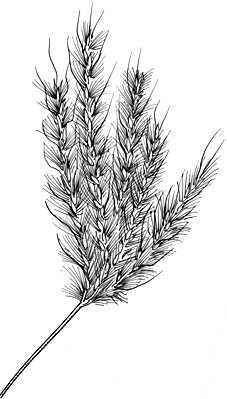
Description: Tufted, usually erect perennials, often with branched culms and glabrous nodes.
Leaves with ligule short, membranous; blade rolled in bud, flat or rolled, rough along the margin.
Inflorescence of racemes on a primary axis or a sub-digitate arrangement of racemes borne on a short axis; racemes bare at the base; joints and pedicels with a distinct discoloured groove, dumbbell-shaped in cross section, more or less hairy. Spikelets more or less hairy, paired, 1 sessile, fertile, awned, breaking up and falling entire at maturity with the axis joints and pedicels, the other spikelet pedicellate, unawned. Sessile spikelets with 1 fertile floret above a sterile floret, awned; callus bearded. Glumes dissimilar, the lower 5–7-nerved, 2-keeled, sometimes with a circular depression (pit); upper narrower, faintly 3-nerved. Lemmas 2, the lower thin, nerveless; upper with a twisted, usually terminal, awn. Palea absent. Pedicellate spikelets sterile, awnless, reduced to 1 or 2 glumes that may enclose a small lemma with a male flower.
Distribution and occurrence: World: c. 35 species, tropical and warm temperate regions. Australia: 9 species (7 species native, 2 species naturalised), all mainland States.
Many species are regarded as valuable components of native pasture.
Text by S. W. L. Jacobs & C. A. Wall
Taxon concept:
Taxa not yet included in identification key
Bothriochloa insculpta
| | Key to the species | |
| 1 | Upper lemma of sessile spikelets narrow but 2-lobed (pull awn out to examine) with the awn between the lobes | 2 |
| Upper lemma of sessile spikelets narrow and without lobes on either side of the awn | 3 |
| 2 | Racemes with dense, long hairs that almost conceal the spikelets; awn straight | Bothriochloa erianthoides |
| Racemes with only sparse hairs that do not conceal the spikelets; awn bent or twisted
Back to 1 | Bothriochloa biloba |
| 3 | Racemes subdigitate, 3–6; sessile spikelets 4.7–7 mm long, pedicellate spikelets usually reduced to glumes(s) | 4 |
| Racemes 4-numerous arranged on a primary axis; sessile spikelets 3–5 mm long; pedicellate spikelets similar to the sessile spikelet but unawned
Back to 1 | 5 |
| 4 | Sessile spikelets 5–7 mm long, awn together with the stipe 20–25 mm long, pedicellate spikelets 4–6 mm long, reduced to 1 or 2 glumes; stamens 3 | Bothriochloa macra |
| Sessile spikelets 4.7–5.3 mm long, awn together with the stipe 15–24 mm long; pedicellate spikelets 2.5–4.5 mm long, reduced to 1 glume; stamen 1
Back to 3 | Bothriochloa decipiens |
| 5 | Main axis of panicle less than 4 cm long, not glandular; lowest racemes exceeding the common axis in length; racemes naked at the base for 2–7 mm; leaves with midrib and margins of blade pale | Bothriochloa ewartiana |
| Main axis of panicle 4–20 cm long; internodes and branches rather obscurely glandular; lowest racemes shorter than the common axis; racemes naked at the base for 10–15 mm; leaves without pale margins
Back to 3 | Bothriochloa bladhii |
|


